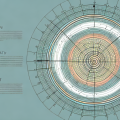The unit circle is an important tool in trigonometry. It offers a complete roadmap for understanding angles, lines, and the relationships between them in mathematics. By using this important tool, students, professionals and mathematicians can find angles, distances and other relationships in a complete and organized way.
Defining the Unit Circle
The unit circle is defined as a circle around a center point, with a radius of one. The circle is then divided into two parts: a circumference, which is the outer line of the circle, and an interior space containing the center point. All the points on the circumference are exactly one unit from the center point.
The unit circle is used in mathematics to help visualize and understand trigonometric functions. It is also used to calculate the length of an arc, the area of a sector, and the coordinates of points on the circumference. The unit circle is an important tool for understanding the relationships between angles and their corresponding trigonometric functions.
Overview of Trigonometry
Trigonometry is the branch of mathematics that focuses on angles and measurements. Fundamentally, it’s concerned with how to use angles to measure certain objects and distances. The unit circle helps make these calculations simpler, since the angles can be plotted on the circle and the relationships between them can be seen easily.
Trigonometry is used in a variety of fields, including engineering, physics, and astronomy. It is also used to calculate the area of a triangle, the length of a side of a triangle, and the angles of a triangle. Additionally, trigonometry can be used to calculate the distance between two points, the height of an object, and the speed of an object.
The Components of the Unit Circle
The unit circle is divided into basic components that are used to identify angles and lines. The most important components of the unit circle include the radius (the length from the center point to any point on the circumference), radii (the measured length between two points on the circumference), arcs (the length between two points along the circumference), tangents (the angle between a point on the circumference and a point on a radius), chords (the line between two points on the circumference), and sines and cosines (determining where a line drawn from the center point meets the circumference.)
The unit circle is a useful tool for understanding the relationship between angles and lines in a circle. It can be used to calculate the area of a circle, the length of an arc, and the angle of a tangent. It can also be used to calculate the sine and cosine of an angle, which can be used to determine the coordinates of a point on the circumference. By understanding the components of the unit circle, it is possible to gain a better understanding of the relationships between angles and lines in a circle.
Understanding Radians and Degrees
Radians and degrees are two different ways of measuring angles and lengths on the unit circle. Radians measure angles in terms of a fraction of a circle and are the primary way to measure angles on the unit circle. Degrees are based on a measurement system of 360 degrees in a full circle, each equal to one degree of arc. Both measurements can provide useful when studying trigonometry.
Exploring the Quadrants of the Unit Circle
The unit circle can be divided into four segments known as quadrants. These sections are labeled as Quadrant I, Quadrant II, Quadrant III, and Quadrant IV. Each quadrant focuses on specific measurements, for example, Quadrant I covers all angles between zero degrees and 90 degrees, while Quadrant II covers all angles between 90 degrees and 180 degrees.
Memorizing Key Points on the Unit Circle
The unit circle can be overwhelming at first glance, as there are a lot of angles to remember. To help make studying easier, it is important to memorize key points in each quadrant. For example, in Quadrant I, some of the key points are 0 degrees, 30 degrees, 45 degrees, and 90 degrees. Additionally, memorizing some of the basic formulas associated with trigonometry can make it easier to figure out measurements on the unit circle.
Using the Unit Circle in Problem Solving
The unit circle is an important tool in trigonometry problem solving. Knowing how to read angles and lengths from the unit circle can help solve problems more quickly and accurately. With practice and familiarity, problem solving with the unit circle can become much simpler.
Tips for Remembering the Unit Circle
Remembering all of the angles and points on the unit circle can be difficult at first. One way to make it easier is by breaking the unit circle into manageable parts. Memorizing the lengths of lines can help create more clarity for students when studying trigonometry. Additionally, drawing sketches or diagrams related to concepts can help make studying easier.
Common Mistakes When Interpreting the Unit Circle
Many common mistakes can be made while interpreting the unit circle or solving trigonometric problems. One mistake is forgetting which quadrant you’re in and relating measurements to it. Another mistake is being unfamiliar with sines and cosines and how they relate to angles and lengths. Finally, learning to read arc lengths correctly can be difficult for some students. With experience and practice, these mistakes can become less common.





